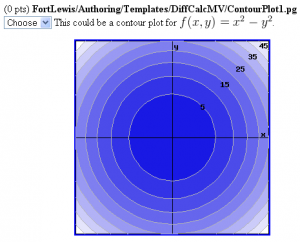Difference between revisions of "ContourPlot1"
m (Removal of non-PGML link.) |
(added historical tag and gave updated problem link) |
||
| Line 1: | Line 1: | ||
| + | {{historical}} |
||
| + | |||
| + | <p style="font-size: 120%;font-weight:bold">This problem has been replaced with [https://openwebwork.github.io/pg-docs/sample-problems/DiffCalcMV/ContourPlot.html a newer version of this problem]</p> |
||
<h2>Contour Plots with a Color Gradient</h2> |
<h2>Contour Plots with a Color Gradient</h2> |
||
Latest revision as of 10:52, 29 June 2023
This problem has been replaced with a newer version of this problem
Contour Plots with a Color Gradient
This PG code shows how to construct a contour plot with a color gradient.
- PGML location in OPL: FortLewis/Authoring/Templates/DiffCalcMV/ContourPlot1_PGML.pg
| PG problem file | Explanation |
|---|---|
|
Problem tagging: |
|
DOCUMENT(); loadMacros( "PGstandard.pl", "MathObjects.pl", "PGgraphmacros.pl", "parserPopUp.pl", ); TEXT(beginproblem()); $refreshCachedImages = 1; |
Initialization:
We will use |
$refreshCachedImages=1;
$showPartialCorrectAnswers = 0;
##################################
# Set-up
Context("Numeric")->variables->are(t=>"Real",x=>"Real",y=>"Real");
#
# Create some graph canvases
#
$gr = init_graph(-5,-5,5,5,axes=>[0,0],pixels=>[300,300]);
$gr->lb('reset');
$gr->lb( new Label(4.7,0.2,'x','black','center','middle'));
$gr->lb( new Label(0.2,4.7,'y','black','center','middle'));
#
# A subroutine for adding the color gradient to the graph object
#
sub makegradient # ($graph, $steps, $r0, $g0, $b0, $r1, $g1, $b1)
{
my ($graph, $steps, $r0, $g0, $b0, $r1, $g1, $b1) = @_;
my $dr = ($r1 - $r0) / $steps;
my $dg = ($g1 - $g0) / $steps;
my $db = ($b1 - $b0) / $steps;
my $r = $r0;
my $g = $g0;
my $b = $b0;
for my $i (0..$steps-1)
{
$graph->new_color("gradient$i",$r,$g,$b);
$r += $dr;
$g += $dg;
$b += $db;
}
return $graph;
}
#
# Add to $gr a 10 step color gradient
#
$gr = &makegradient($gr, 10,
0,0,225, # RGB blue
255,255,255 # RGB white
);
#
# Circular contours as parametrized curves
#
foreach my $k (5,10,15,20,25,30,35,40,45) {
my $a = sqrt($k);
$fn = new Fun(
Formula("$a*cos(t)")->perlFunction,
Formula("$a*sin(t)")->perlFunction,
$gr
);
$fn->domain(0,6.3);
$fn->color("gray");
$fn->steps(60);
$fn->weight(1);
}
#
# Fill with gradient colors between contours
#
foreach my $i (0..9) {
my $a = sqrt(2)/2 * sqrt(5*$i) - 0.1;
$gr->fillRegion([ $a, $a, "gradient$i"]);
$gr->fillRegion([-$a, $a, "gradient$i"]);
$gr->fillRegion([-$a,-$a, "gradient$i"]);
$gr->fillRegion([ $a,-$a, "gradient$i"]);
}
#
# Label the contours
#
foreach my $k (5,15,25,35,45) {
$gr->lb( new Label(0.707*sqrt($k),0.707*sqrt($k),$k,'black','center','middle'));
}
$pop = PopUp(["Choose","True","False"],"False");
|
Setup:
By default, graph objects only know a few named colors, so if you want to have a color gradient, you'll need to add a bunch of named colors to the graph. The Unfortunately, we have to do everything manually, including constructing the contour curves as parametric curves, filling the spaces between curves with colors from the color gradient, and labeling each contour curve. |
BEGIN_PGML [@ $pop->menu() @]* This could be a contour plot for [` f(x,y) = x^2 - y^2 `]. >> [@ image(insertGraph($gr),width=>300,height=>300,tex_size=>450) @]* << END_PGML |
Main Text: We ought to have asked a more interesting question. |
$showPartialCorrectAnswers = 0; ANS( $pop->cmp() ); |
Answer Evaluation: |
Context()->texStrings;
BEGIN_SOLUTION
Solution explanation goes here.
END_SOLUTION
Context()->normalStrings;
COMMENT('MathObject version.');
ENDDOCUMENT();
|
Solution: |
